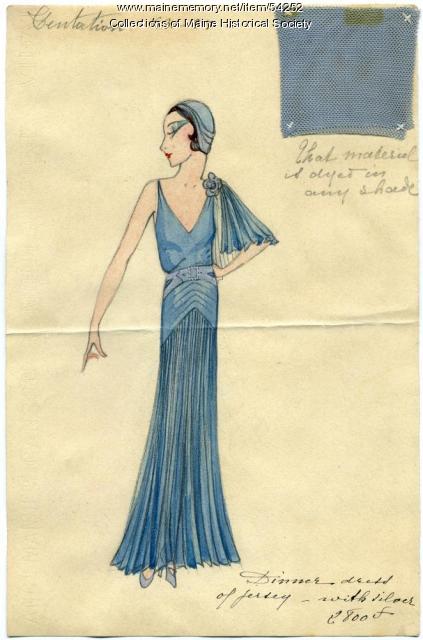Keywords: Students
- Historical Items (1627)
- Tax Records (0)
- Architecture & Landscape (6)
- Online Exhibits (90)
- Site Pages (348)
- My Maine Stories (27)
- Lesson Plans (67)
Online Exhibits
Your results include these online exhibits. You also can view all of the site's exhibits, view a timeline of selected events in Maine History, and learn how to create your own exhibit. See featured exhibits or create your own exhibit
Exhibit
Maine is home to dozens of summer-long youth camps and untold numbers of day camps that take advantage of water, woods, and fresh air. While the children, counselors, and other staff come to Maine in the summer, the camps live on throughout the year and throughout the lives of many of the campers.
Exhibit
Fallen Heroes: Jewish Soldiers and Sailors, The Great War
Thirty-four young Jewish men from Maine died in the service of their country in the two World Wars. This project, including a Maine Memory Network exhibit, is meant to say a little something about some of them. More than just names on a public memorial marker or grave stone, these men were getting started in adult life. They had newly acquired high school and college diplomas, they had friends, families and communities who loved and valued them, and felt the losses of their deaths.
Exhibit
For one hundred years, Acadia National Park has captured the American imagination and stood as the most recognizable symbol of Maine’s important natural history and identity. This exhibit highlights Maine Memory content relating to Acadia and Mount Desert Island.
Exhibit
Fallen Heroes: Those Who Gave Their Lives: World War II
At least twenty-three Jewish men from Maine died in the military during World War II. Photographs and other memorabilia are available for fewer than half of them. Read more about them.
Exhibit
Fallen Heroes: Maine's Jewish Sailors and Soldiers
Thirty-four young Jewish men from Maine died in the service of their country in the two World Wars. This project, including a Maine Memory Network exhibit, is meant to say a little something about some of them. More than just names on a public memorial marker or grave stone, these men were getting started in adult life. They had newly acquired high school and college diplomas, they had friends, families and communities who loved and valued them, and felt the losses of their deaths.
Exhibit
The Doris Hamlin, a four-masted schooner built at the Frye-Flynn Shipyard in Harrington, was one of the last vessels launched there, marking the decline of a once vigorous shipbuilding industry in Washington County.
Exhibit
Otisfield's One-Room Schoolhouses
Many of the one-room schoolhouses in Otisfield, constructed from 1839 through the early twentieth century, are featured here. The photos, most of which also show teachers and children, were taken between 1898 and 1998.
Exhibit
Throughout the history of the state, residents have protested, on paper or in the streets, to increase rights for various groups, to effect social change, to prevent social change, or to let their feelings be known about important issues.
Exhibit
KVVTI's Gilman Street Campus, 1978-1986
The Gilman Street building began its life in 1913 as Waterville High School, but served from 1978 to 1986 as the campus of Kennebec Valley Vocational Technical Institute. The building helped the school create a sense of community and an identity.
Exhibit
A Town Is Born: South Bristol, 1915
After being part of the town of Bristol for nearly 150 years, residents of South Bristol determined that their interests would be better served by becoming a separate town and they broke away from the large community of Bristol.
Exhibit
Doing Good: Medical Stories of Maine
Throughout Maine’s history, individuals have worked to improve and expand medical care, not only for the health of those living in Maine, but for many around the world who need care and help.
Exhibit
Hermann Kotzschmar: Portland's Musical Genius
During the second half of the 19th century, "Hermann Kotzschmar" was a familiar household name in Portland. He spent 59 years in his adopted city as a teacher, choral conductor, concert artist, and church organist.
Exhibit
Fashion for the People: Maine's Graphic Tees
From their humble beginnings as undergarments to today's fashion runways, t-shirts have evolved into universally worn wardrobe staples. Original graphic t-shirts, graphic t-shirt quilts, and photographs trace the 102-year history of the garment, demonstrating how, through the act of wearing graphic tees, people own a part of history relating to politics, social justice, economics, and commemorative events in Maine.
Exhibit
Like other immigrant groups, Jews came to Maine to make a living and enjoy the natural and cultural environment. Their experiences have been shaped by their occupational choices, Jewish values and, until recently, experiences of anti-Semitism.
Exhibit
Evergreens and a Jolly Old Elf
Santa Claus and evergreens have been common December additions to homes, schools, businesses, and other public places to America since the mid nineteenth century. They are two symbols of the Christian holiday of Christmas whose origins are unrelated to the religious meaning of the day.
Exhibit
Horace W. Shaylor: Portland Penman
Horace W. Shaylor, a native of Ohio, settled in Portland and turned his focus to handwriting, developing several unique books of handwriting instruction. He also was a talented artist.
Exhibit
One Hundred Years of Caring -- EMMC
In 1892 five physicians -- William H. Simmons, William C. Mason, Walter H. Hunt, Everett T. Nealey, and William E. Baxter -- realized the need for a hospital in the city of Bangor had become urgent and they set about providing one.
Exhibit
Cosmopolitan stylings of Mildred and Madeleine Burrage
Born in Portland, sisters Mildred Giddings Burrage (1890-1983) and Madeleine Burrage (1891-1976) were renowned artists and world travelers. Mildred's experiences studying painting in Paris and Italy, and the sisters' trips to Mexico and Guatemala inspired their artwork and shared passions for cosmopolitan and stylish attire. Housed at Maine Historical Society, The Burrage Papers include selections of original advertising drawings called "line sheets" from Parisian fashion houses dating from 1928 to 1936. Images of Madeleine's gemstone jewelry and Mildred's artwork accompany intimate family photographs of the sisters.
Exhibit
From French Canadians to Franco-Americans
French Canadians who emigrated to the Lewiston-Auburn area faced discrimination as children and adults -- such as living in "Little Canada" tenements and being ridiculed for speaking French -- but also adapted to their new lives and sustained many cultural traditions.
Exhibit
Toy Len Goon: Mother of the Year
Toy Len Goon of Portland, an immigrant from China, was a widow with six children when she was selected in 1952 as America's Mother of the Year.
Exhibit
Members of the Washburn family of Livermore participated in the Civil War in a variety of ways -- from Caroline at the homefront, to Samuel at sea, Elihu, as a Congressman from Illinois, and Israel governor of Maine. The family had considerable influence politically on several fronts.
Exhibit
John Hancock's Relation to Maine
The president of the Continental Congress and the Declaration's most notable signatory, John Hancock, has ties to Maine through politics, and commercial businesses, substantial property, vacations, and family.
Exhibit
Cultures from the ancient Greeks and Chinese to contemporary societies have set aside time to give thanks, especially for the harvest. In 1941, the United States set a permanent date for the observance.
Exhibit
Maine Medical Center, Bramhall Campus
Maine Medical Center, founded as Maine General Hospital, has dominated Portland’s West End since its construction in 1871 on Bramhall Hill. As the medical field grew in both technological and social practice, the facility of the hospital also changed. This exhibit tracks the expansion and additions to that original building as the hospital adapted to its patients’ needs.
























